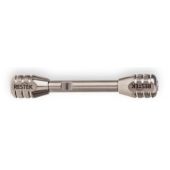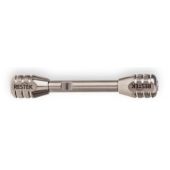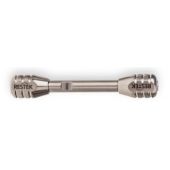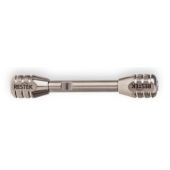Run Ultrashort-Chain PFAS (C2, C3) and Conventional PFAS on One LC Column
Adding ultrashort-chain compounds to an existing PFAS method can now be achieved on Raptor Polar X LC columns. In this fast, isocratic LC-MS/MS analysis, the unique hybrid ligand (HILIC and ion exchange) provides effective retention and analysis of C2, C3, C4, C6, C8, and alternative PFAS in potable and non-potable waters.
- Unique stationary phase provides proper chromatographic retention of small, polar ultrashort-chain PFAS as well as short- and long-chain PFAS
- Fast and simple isocratic LC-MS/MS method allows high-throughput PFAS analysis
- Consistent column performance ensures accurate results
Current LC-MS/MS methods for per- and polyfluoroalkyl substances (PFAS) analysis are focused on short-chain (C4-C6), long-chain (C8 and up), and alternative or replacement compounds and do not include newly trending ultrashort-chain (C2 and C3) compounds. The ultrashort-chain PFAS are growing in importance because they are ubiquitous in environmental waters (e.g., rain, river, and groundwaters) and have been reported as being at least 40% of the total PFAS in water samples. Ultrashort-chain PFAS include trifluoroacetic acid (TFA), perfluoropropanoic acid (PFPrA), perfluoroethane sulfonate (PFEtS), and perfluoropropane sulfonate (PFPrS), with TFA being the most abundant as well as one of the most difficult to analyze. True comprehensive PFAS analysis methods that provide reliable results for ultrashort-chain compounds (including TFA) as well as alternative and legacy PFAS are essential for water monitoring programs.
The critical challenge encountered with TFA analysis is that it exhibits limited retention and/or poor chromatography on reversed-phase columns and HILIC columns. Other columns that emphasize strong ion-exchange mechanisms can pose the opposite problem: too much retention and poor peak shapes. In contrast, TFA can be reliably retained and analyzed on Raptor Polar X columns because they contain a unique hybrid ligand that blends HILIC and ion-exchange retention mechanisms. As demonstrated here, a fast and simple LC-MS/MS method was established for comprehensive PFAS analysis that includes C2, C3, C4, C6, C8, and alternative PFAS. Even longer-chain PFAS are possible, too. This method can be applied to both potable and non-potable water analysis and provides convenient setup and high throughput for labs interested in adding ultrashort-chain compounds to an existing PFAS assay.

| Peaks | tR (min) | Conc. (ng/L) | Precursor Ion | Product Ion | ||
|---|---|---|---|---|---|---|
| 1. | 11-Chloroeicosafluoro-3-oxanonane-1-sulfonate (11CL-PF3OUdS) | 1.25 | 400 | 630.78 | 450.80 | |
| 2. | 9-Chlorohexadecafluoro-3-oxanonane-1-sulfonate (9Cl-PF3ONS) | 1.34 | 400 | 530.78 | 350.85 | |
| 3. | Perfluorooctanesulfonic acid (PFOS) | 1.38 | 400 | 498.84 | 79.97 | |
| 4. | Perfluorohexanesulfonic acid (PFHxS) | 1.49 | 400 | 398.90 | 79.97 | |
| 5. | Perfluorobutanesulfonic acid (PFBS) | 1.64 | 400 | 298.97 | 79.97 | |
| 6. | Perfluoropropanesulfonic acid (PFPrS) | 1.73 | 400 | 248.97 | 79.98 | |
| 7. | Perfluoroethanesulfonic acid (PFEtS) | 1.86 | 400 | 198.98 | 79.92 | |
| 8. | Hexafluoropropylene oxide dimer acid (HFPO-DA) | 2.06 | 400 | 284.97 | 168.92 | |
| 9. | Perfluorooctanoic acid (PFOA) | 2.11 | 400 | 412.90 | 368.91 | |
| 10. | Ammonium 4,8-dioxa-3H-perfluorononanoate (ADONA) | 2.15 | 400 | 376.90 | 250.93 | |
| 11. | Perfluorohexanoic acid (PFHxA) | 2.36 | 400 | 312.97 | 268.90 | |
| 12. | Perfluorobutanoic acid (PFBA) | 2.76 | 400 | 212.97 | 168.97 | |
| 13. | Perfluoropropionic acid (PFPrA) | 3.06 | 400 | 163.03 | 119.01 | |
| 14. | Trifluoroacetic acid (TFA) | 3.77 | 400 | 113.03 | 69.01 |
| Column | Raptor Polar X (RSK-9311A52) | ||||||||||||
|---|---|---|---|---|---|---|---|---|---|---|---|---|---|
| Dimensions: | 50 mm x 2.1 mm ID | ||||||||||||
| Particle Size: | 2.7 µm | ||||||||||||
| Temp.: | 40 °C | ||||||||||||
| Standard/Sample | |||||||||||||
| Diluent: | 50:50 Water:methanol | ||||||||||||
| Conc.: | 400 ng/L | ||||||||||||
| Inj. Vol.: | 10 µL | ||||||||||||
| Mobile Phase | |||||||||||||
| A: | Water, 10 mM ammonium formate, 0.05% formic acid | ||||||||||||
| B: | 60:40 Acetonitrile:methanol, 0.05% formic acid | ||||||||||||
|
|||||||||||||
| Detector: | MS/MS | ||||||||||||
| Ion Mode: | ESI- | ||||||||||||
| Mode: | MRM | ||||||||||||
| Instrument: | UHPLC |



